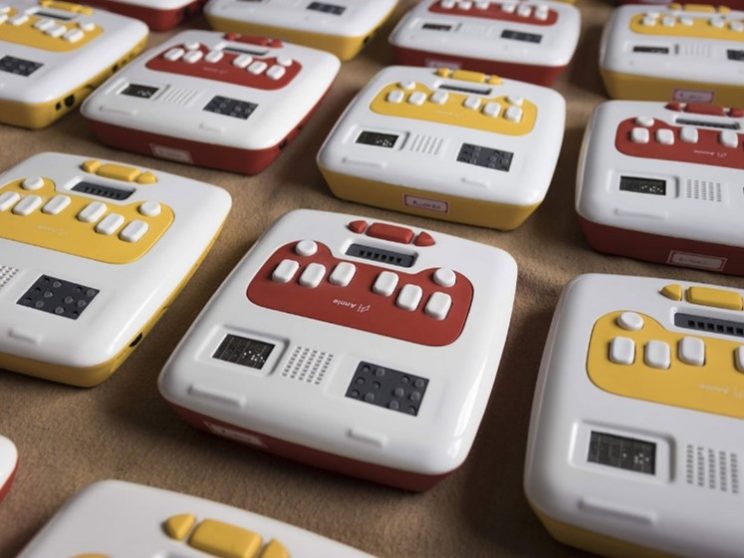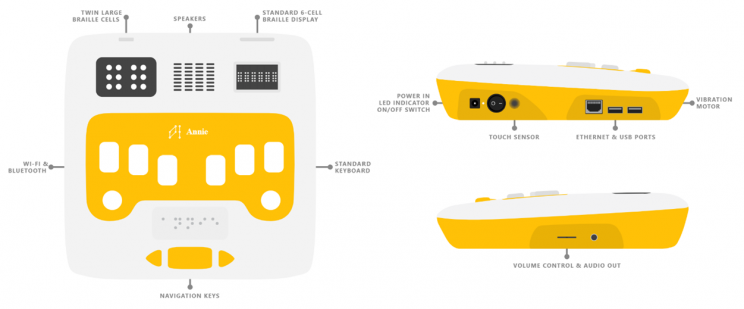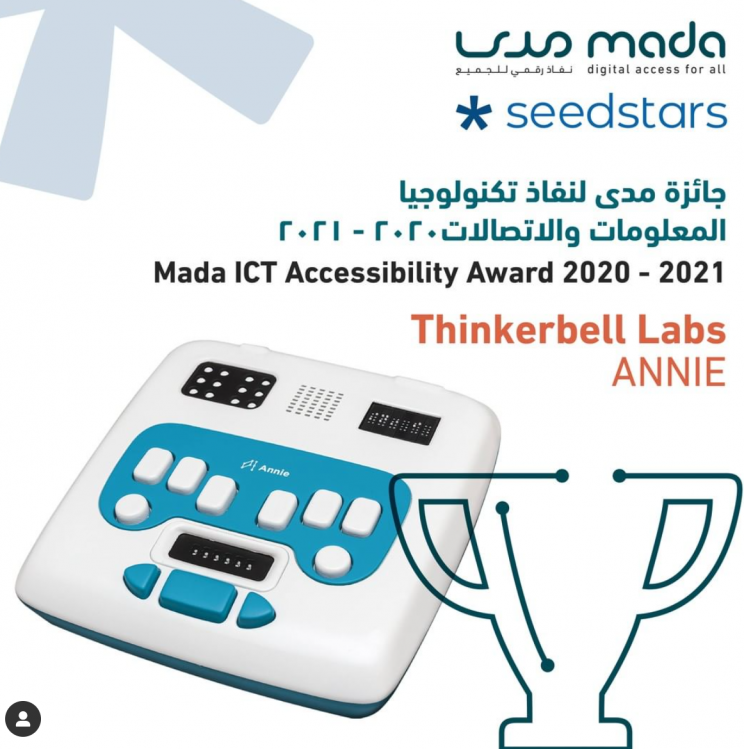Thinkerbell Annie: World’s First Self-Learning Braille Literacy Device – Supported by Mada Innovation Program
Research article  Open access |
Available online on: 25 January, 2022 |
Last update: 21 June, 2022
Open access |
Available online on: 25 January, 2022 |
Last update: 21 June, 2022
Abstract
In 2016, a four-member team from Thinkerbell labs came together in building an innovative, accessible literacy braille device to make education inclusive for people with visual impairment. Developed by Thinkerbell Labs, Annie is a self-learning braille device that several visually-impaired students in school. Annie was built to be a comprehensive Braille self-learning device, one that could make learning fun, engaging, and intuitive for blind students. Furthermore, Annie was the winners of the Mada Seed stars Awards 2021 under Mada Innovation Program. In addition to it, Annie was designed to the learning experience prioritizing learner retention as well as sustained engagement with Annie’s contents, be it from the software, content, or hardware perspective.
Introduction
Braille literacy rates across the world are abysmally low. The shortage of trained educators is one of the greatest impediments in the spread and adoption of Braille as learning the script involves heavy dependence on the special educator. The fewer the teachers, the harder it is for visually impaired children to get the attention they need for education truly beneficial to them (Wagh, Pragath and Sukle, 2016).
Furthermore, the modes of teaching and learning Braille have remained surprisingly unchanged for several decades. Educational technology initiatives have often significantly changed how learning and teaching have been accomplished. Remote learning over the internet, for example, has been touted as a useful educational tool during the COVID-19 pandemic (McKenzie, 2021). However, these methods have faced criticism for widening the digital divide and not accounting for many sections of society – such as persons with disabilities – whose conditions of access to technology are different.
Identifying this problem and with a belief that Braille is a very self-learning process led to the birth of Thinker bell Labs in 2016. Annie helps in the early schooling of visually impaired students with its gamified audio lessons over Braille-based hardware. Thinker bell Labs’ hopes to change the status quo by tackling these challenges via the Braille literacy device, Annie.
Background
Primarily, Braille is an essential system of learning for visually impaired people. It is the method which enables them to read and write (Lahiri et al., 2020).Various factors like lack of government initiatives, limitations of tutors, lack of personal attention etc. are the possible reasons for this state. Mada Innovation Program aims at supporting the development of a self-learning Braille device which can help people with visual impairments. The solution aims at developing an easy to learn kit that will behave as a teacher and assists the visually challenged people for learning the Braille learning system. The designed system uses a Braille keypad and microphone to take input and produces speech as output. By implementing the designed system for visually challenged individuals, Braille literacy can be affected positively. The solution is so designed that it optimizes cost and speed of operation of the device.
Journey of Thinkerbell Annie
In 2014, Sanskriti Dawle and Aman Srivastava, co-founders of Thinkerbell Labs and then-students at BITS Palani, Goa Campus, conceptualised Annie. Made with a Raspberry Pi and coded in Python, Annie started as a simple prototype with a single Braille cell and an alphabet song. The last 7 years were spent listening to stakeholders involved and continuously innovating to ensure Annie solved the most pressing issues related to Braille learning. Now it’s a comprehensive Braille learning device, with students being able to learn reading, writing, and typing through interactive lessons in over 10 languages across Grade 1 and Grade 2 braille.

Figure 1. Braile Learning device Annie by Thinkerbell
Today, Annie is a UNDP (United Nations Development Programme) best practice and has been commended by top policy and visual rehab organisations in India and was even applauded by the Prime Minister of India. Annie’s help over 1000 children across 5 countries learn Braille more effectively (Bora G, 2019). The past 7 years has seen Annie and Thinkerbell Labs grow in many ways, and as they continue to expand across regions, they’re set to grow even further (Wagh, 2019).
Annie is the world’s first self-learning Braille literacy device. The technology behind Annie is designed to empower the learner to engage with Braille learning materials in their native language on their own, without the need for constant attention from a teacher. It is an effective self-learning tool for reading, writing, and typing in Braille that allows learners to take their time with their lessons and practice until they’re satisfied with their work.
The device consists of two Braille displays for learners to read their lessons and play the gamified exercises on – a Large Braille Display, whose two cells have larger-than-usual dots, to help beginners easily read the script, and a Standard Braille Display, consisting of a row of six standard-sized Braille cells. There is a standard Braille keyboard consisting of six keys (corresponding to each of the dots in a Braille cell) to learn typing on, a digital Braille slate – the first of its kind – that can be used with a standard stylus to learn writing on, and navigational keys for device manipulation. Furthermore, the device has speakers and a headphone jack for the learner to absorb the auditory elements of Annie, such as in-exercise instructions. Annie also closes the long and arduous feedback loop on exercises by allowing children to learn from and practice on the same device, providing instantaneous feedback (Putrevu, 2019).

Figure 2. Technical Features of Annie (Wagh, 2016)
Annie’s interactive pedagogy is established based on two aspects. First, that Annie is, after all, meant to help children, who like to play and learn from their surroundings, compete with their peers, and can get frustrated in the mundanity of a classroom. Secondly, that the learning ability of visually impaired children is limited not by their disabilities, but by the conditions of their education and the often-outmoded forms of engagement with Braille – engagement that sighted children often have ready access to. Therefore, Annie’s gamified and interactive lessons guide learners to consistently practice and improve their Braille skills through touch and sound. Integrating Annie into the classroom experience has been essential to establishing an effective learning environment for both learners and teachers. This led to the conceptualization of Annie Resource Centres and Annie Smart Classes. An Annie Smart Class is ideal for a special school and consists of multiple Annie’s set up in internet-enabled classrooms that could be supervised by teachers, allowing for collaborative and competitive learning on Annie.
An Annie Resource Center is a smaller version of an Annie Smart Class and is ideal for an inclusive school with fewer visually impaired children. Both the setups are holistic learning ecosystems thanks to the learning management system Helios that works in tandem with Annie. Helios empowers teachers to track their students’ performance, plan their lessons, and therefore break the barrier of teachers needing to pay individual attention to students. This also allows for parents and administrators – many of whom might not know Braille themselves – to understand the learning journey of the children through a shared platform and play an important role in it.
Mada – Seedstars ICT Accessibility Awards 2021
Furthermore, Mada partners with Seedstars to promote the ICT Accessibility Solutions with the goal of supporting Accessibility startups in Qatar and beyond to benefit and improve the lives of PWD. Seedstars and Mada share a common vision to support innovation by working with the best startups in the field and offering them with suitable funding and subject matter expertise. The prize money is utilized for enhancing the innovative winning solution and a marketable product to effectively impact the targeted users.
Following the success of Mada ICT Accessibility Award on Virtual Seedstars Global Summit 2020/21, Mada continues to collaborate with Seedstars to enable startups to develop impacting solutions to improve the lives of PWD. For this year’s award, 4 finalists were selected to pitch in Seedstars Regional Summit and subsequently, from which 2 finalists were chosen to advance to the final round and pitch in the Seedstars Global Summit that was held virtually on May 20, 2021. Thinkerbell Annie was the winner of Mada Seedstars Award 2021 (Mada Center, 2021).

Figure 3. Mada Seedstars ICT Accessibility Awards 2021 – Thinkerbell (Mada Center, 2021)
The announcement took place during the Seedstars Global Summit 2021 on May 20, 2021, which was a 2-hour event held virtually due to the travel and gathering restrictions imposed because of the COVID-19 outbreak.
Conclusion
Coming to future, Annie, which currently supports 7 languages (English, French, Spanish, Hindi, Marathi, Kannada, and Telugu) is working on more vernacular content in regional as well as international languages including Arabic. Furthermore, Annie have seen initial traction in the UK and the Middle East and have plan to grow the footprint in these geographies in the coming time to ensure that any student with a disability can learn at the same level in an inclusive mainstream setup. Mada Intent to extend its support through Endorsement program for Thinkerbell Labs in bringing Annie to all visually impaired students in mainstream schools as well.
References
Bora, G. (2019, December 5). How this Anand Mahindra-backed startup is empowering the visually impaired. The Economic Times. https://economictimes.indiatimes.com/small-biz/startups/features/anand-mahindra-backed-startup-is-empowering-the-visually-impaired-annie-thinkerbell-labs/articleshow/72342128.cms?from=mdr
Lahiri, A., Othman, A., Al-Thani, D. A., & Al-Tamimi, A. (2020, September). Mada Accessibility and Assistive Technology Glossary: A Digital Resource of Specialized Terms. In ICCHP (p. 207).
Mada Center. (2021, September 1). Thinkerbell Annie. Mada Innovation Program. https://mip.mada.org.qa/solution/thinkerbell-annie/
McKenzie, L. (2021). Bridging the digital divide. In Plastics Engineering. https://doi.org/10.1002/j.1941-9635.2017.tb01690.x
Putrevu, S. (2019b, December 20). How Annie, a Braille device developed by Anand Mahindra-backed Thinkerbell Labs, is helping the blind learn by. YourStory.Com. https://yourstory.com/socialstory/2019/11/anand-mahindra-thinkerbell-blind-braille-device-annie/amp
Wagh, Prajapati, Salunke, P. W. U. P. P. S. (2016, March 1). E-Braille-a self-learning Braille device. IEEE Conference Publication | IEEE Xplore. https://ieeexplore.ieee.org/document/7561162
